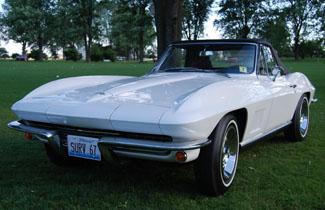Corvette History 
Select a year and a model to view the vast history of Corvettes.
All Models

Some consider Chevrolet’s 1967 Series 9000 Corvette Sting Ray to be the best looking Corvette of its era. It is generally considered the most refined of the original Sting Ray models of 1963-1967. Its styling was cleaned up just a little from the 1966 appearance, even though the same egg-crate style grille with Argent Silver finish was carried over. The same smooth hood seen in 1966 was re-used on cars with small-block Chevy engines. Big-block cars had a large front-opening hood air scoop in place of the power blister hood used in 1966.
The crossed flags badge on the nose of the 1967 Corvette had a widened “V” at its top. On the sides of the front fenders were five vertical and functional louvers that slanted towards the front of the car. Minor changes were made to the interior. The most noticeable was the relocation of the parking brake from under the dash to the center console. The new headliner was cushioned with foam and fiber material. Four-way flashers, directional signals with a lane-change function, larger interior vent ports and folding seat-back latches were all new.
At the rear of the car, dual round taillights were placed on each side of the Corvette (instead of a taillight and optional back-up light). The twin back-up lights were now mounted in the center of the rear panel, above the license plate. The two-piece bumper ran vertically next to the license plate, then horizontally below the taillights, with each side curving around the rear of the body. The standard rear-exit exhausts protruded through round ports underneath the two bumper.
Standard Corvette equipment included: a new dual-chamber brake master cylinder; six-inch wide slotted rally wheels with trim rings; an odometer; a clock; carpeting and a tachometer. The optional finned aluminum wheels were changed in design and had a one-year-only, non-knock-off center. The 10 lacquer exterior finishes offered were Tuxedo Black; Ermine White; Elkhart Blue; Lyndale Blue; Marina Blue; Goodwood Green; Rally Red; Silver Pearl; Sunfire Yellow and Marlboro Maroon. All convertibles came with a choice of a Black, White or Teal Blue soft top. The all-vinyl foam-cushioned bucket seats came in Black, Red, Bright Blue, Saddle, White and Blue, White and Black, Teal Blue and Green.
The 1967 Corvette was available with three transmissions The standard gearbox was a three-speed manual all-synchromesh transmission with floor-mounted gear shifter. An automatic transmission with floor-mounted gear shifter was optional equipment. A high-performance all-synchromesh four-speed manual with floor-mounted gear shifter was optional. A special high-performance four-speed manual all-synchromesh close-ratio with floor-mounted gear shifter was also optional equipment. A special heavy-duty four-speed manual all-synchromesh close-ratio with floor-mounted gear shifter was also optional.
The 1967 Corvette retained a 97-in. wheelbase and was 175.2 inches long. Overall height: was 49.6 inches and overall width was 69.6 inches. The car had a 57.6 inch front and 58.3-inch rear tread. Ground clearance was 5 inches with the stock 7.75 x 15 redwall or whitewall tires. The full-length steel ladder type had five cross members and separate body mounts.
Up front was an Independent front suspension with unequal-length A-arms, coil springs; tubular shocks and an anti-roll bar. The rear suspension was also an Independent design with transverse leaf springs; transverse struts; half shafts with universal-joints; trailing arms and tube shocks. Saginaw recirculating ball steering was fitted. It had a 17.6:1 ratio and went 2.9 turns lock-to-lock. That produced a turning circle of 41.6 ft. Corvettes had a hypoid semi-floating rear axle and hydraulic four-wheel vented discs disc brakes with one caliper per wheel. The standard rear axle ratio was 3.55:1. Available rear axle gear ratios included 3.08:1; 3.36:1; 3.55:1; 3.70:1; 4.11:1; 4.56:1.
Eighty-eight percent of 1967 Corvettes came with four-speed manual; 10.1 percent had Powerglide; 20.8 percent had power brakes; 16.5 percent had air-conditioning; 10.5 percent had a tilting steering wheel and 25.1 percent came with power steering.
A 327 cid 300 hp V-8-powered ’67 Corvette would go from 0-to-60 mph in 7.8 seconds and from 0-to-100 mph in 23.1 seconds.
The Corvette used a full-length steel ladder type frame with five cross members and separate fiberglass body. Independent upper and lower A-arms, unequal-length wishbones; coil springs; an anti-roll bar and tubular shocks made up the front suspension. An independent rear suspension had a fixed differential; nine leaf springs; lateral struts and universally-jointed axle shafts; radius arms and direct-acting shock absorbers. Rear axle ratios were: 3.36:1 (standard) and 4.11:1; 4.56:1; 3.08:1; 3.55:1; 3.70:1 (all optional).